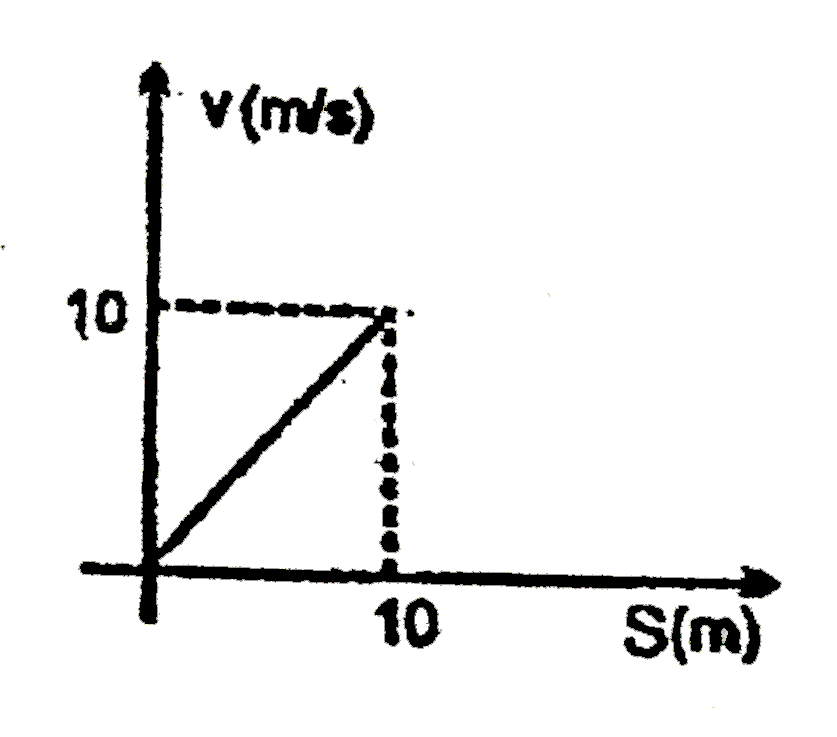The displacement x of a particle at the instant when its velocity v is given by v=√3x+16. Find its acceleration and initial velocity
To solve the problem, we need to find the acceleration and the initial velocity of a particle whose velocity v is given by the equation:
v=√3x+16
Step 1: Square the velocity equation
First, we will square both sides of the equation to eliminate the square root:
v2=3x+16
Step 2: Rearrange the equation
Next, we can rearrange the equation to express x in terms of v:
3x=v2−16
x=v2−163
Step 3: Differentiate to find acceleration
To find the acceleration a, we will differentiate the velocity v with respect to time t. We know that acceleration is the derivative of velocity:
a=dvdt
Using the chain rule, we can express this as:
a=dvdx⋅dxdt=dvdx⋅v
Step 4: Find dvdx
Now, we need to find dvdx. We can differentiate v with respect to x:
v=√3x+16
Differentiating both sides:
dvdx=12√3x+16⋅3=32√3x+16
Step 5: Substitute dvdx into the acceleration equation
Now we can substitute dvdx back into the acceleration equation:
a=32√3x+16⋅v
Step 6: Substitute v back into the equation
Since v=√3x+16, we can replace v in the acceleration equation:
a=32√3x+16⋅√3x+16=32
Step 7: Find the initial velocity
From the equation v2=3x+16, we can find the initial velocity when x=0:
v2=3(0)+16=16
v=√16=4
Final Results
- The acceleration a=1.5m/s2
- The initial velocity u=4m/s
First, we will square both sides of the equation to eliminate the square root:
Next, we can rearrange the equation to express x in terms of v:
x=v2−163
To find the acceleration a, we will differentiate the velocity v with respect to time t. We know that acceleration is the derivative of velocity:
Now, we need to find dvdx. We can differentiate v with respect to x:
Now we can substitute dvdx back into the acceleration equation:
Since v=√3x+16, we can replace v in the acceleration equation:
From the equation v2=3x+16, we can find the initial velocity when x=0:
v=√16=4
- The acceleration a=1.5m/s2
- The initial velocity u=4m/s
Similar Questions
The displacement of a particle along the x-axis is given by x=3+8t+7t2. Obtain its velocity and acceleration at t=2s.
View SolutionA particle moves along the x-axis obeying the equation x=t(t−1)(t−2), where x is in meter and t is in second
a. Find the initial velocity of the particle.
b. Find the initial acceleration of the particle.
c. Find the time when the displacement of the particle is zero.
d. Find the displacement when the velocity of the particle is zero.
e. Find the acceleration of the particle when its velocity is zero.
View SolutionA particle is executing SHM given by x=Asin(πt+ϕ). The initial displacement of particle is 1cm and its initial velocity is πcm/sec. Find the amplitude of motion and initial phase of the particle.
View SolutionThe displacement x of a particle moving in one direction is given by t=√x+3 , where x in meter and t in sec. What is its displacement when its velocity is zero
View SolutionThe displacement of a particle moving along the x-axis is given by equation x=2t3−21t2+60t+6.The possible acceleration of the particle when its velocity is zero is
View SolutionThe distance moved by the particle in time is given by x=t3−12t2+6t+8 . At the instant when its acceleration is zero, the velocity is (a) 42 (b) -42 (c) 48 (d) -48
View SolutionIf the velocity of a particle is given by v=(180−16x)12ms, then its acceleration will be
View SolutionIf the velocity of a particle is given by v=(180−16x)12ms, then its acceleration will be
View SolutionVelocity (v) versus displacement (s) graph of a particle moving in a straight line is shown in figure. Corresponding acceleration (a) versus velocity (v) graph will be

View SolutionThe velocity of any particle is related with its displacement As, x=√v+1, Calculate acceleration at x=5m.
View Solution
